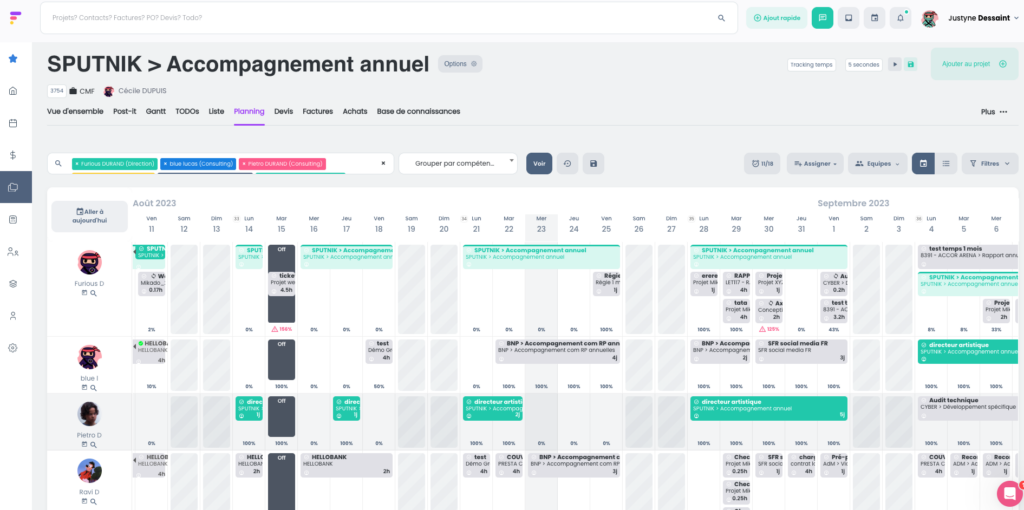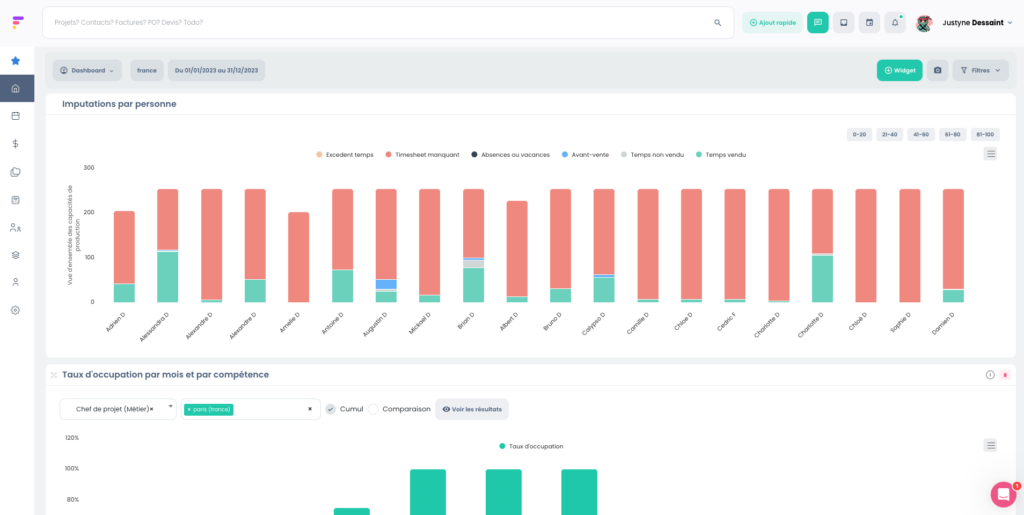Resource management in agencies and firms is an everyday challenge. With unexpected events, new projects to kick off, and rush periods to handle, anticipation and planning can quickly become a headache. Poor management leads to mounting delays, skyrocketing costs, and plummeting profitability!
Fortunately, with the right tools and practices, these challenges can be turned into opportunities.
How clear is your visibility on your workload plan?
Just to remind you, the workload plan is like a calendar for your team, but more sophisticated. It’s where every task, project, and resource is meticulously scheduled to avoid conflicts and maximize efficiency.
With good planning and project management, you can anticipate the unexpected, optimize your resources and guarantee the profitability of your assignments.
Now, take a moment to reflect: how much visibility do you have on your workload plan? 1 week, 1 month, 3 months (be honest)?
This seemingly simple question is actually crucial. For any production manager, anticipating staffing needs, billing periods, and, by extension, the company’s profitability is essential.
On average, agencies and service companies have visibility of only 1 to 3 weeks on their workload plans (ouch), which makes it challenging to anticipate and adjust recruitment and skills to ongoing projects.
Imagine a team of creatives in the middle of launching an ad campaign: without visibility on the coming weeks, you suddenly discover that JB, the key graphic designer, is going on vacation next week, leaving the team unable to finish the project.
This not only complicates anticipation but also makes it nearly impossible to adapt recruitment and skills to commercial needs.
At Furious, we’ve found that having at least 2 months of visibility allows better anticipation of rush periods—and, more importantly, peace of mind regarding your working capital needs. And no, achieving this level of visibility isn’t impossible if you implement the right habits and tools.
The majority of agencies report having difficulty planning their resources more than two weeks in advance.
How can you extend your visibility to several months?
To improve this visibility, it is crucial to centralize information and make it accessible to all stakeholders. This makes it easier to anticipate unforeseen events and plan for vacation periods, customer absences and project validation phases. Using visual tools such as PERT diagrams or Gantt views helps to manage critical tasks efficiently, whatever the methodological framework you adopt (agile vs. v-cycle).
With over 5 years’ experience and more than 1,500 service companies supported, we’ve put together a checklist to help you plan ahead, anticipate and avoid rushes.
Step 1: Centralize project-related information
One of the main challenges for agencies is to centralize project information. This is one of the essential principles of project management principles for ensuring global visibility and facilitating the anticipation of changes and unforeseen events.
By using project planning software, you can centralize all key data, visualize schedules, and efficiently anticipate the needs of your teams, while reducing errors due to scattered information. In complex projects, such as those based on the v-cycle, this centralization becomes even more crucial to ensure compliance with predefined milestones and avoid delays. This process of hierarchical “silos” runs counter to fluid collaboration, a criterion that is all the more important in service companies where employees rarely work alone on a project/customer.
The result? A lack of communication can lead to delays, errors and poor coordination between teams.
Rush periods, when the time sold to complete a project comes to an end without the whole mission having been achieved, are frequent.
These high-pressure periods can lead to extra delays and work overload for teams, affecting the quality of the final work.
To avoid this, it is essential to share project visibility with all teams.
Our advice:
Provide your teams with simple, real-time updated metrics (project dates, progress status, planned and billed workload) as well as visual schedules showing time allocated per person. For instance, you can set up alerts at strategic moments, such as when key stakeholders are on vacation, to better anticipate and plan ahead.
Looking for a better way to manage your resources? Look no further.

Furious allows you to visualize schedules and alerts you in real-time if there are any overruns (such as project budget consumption in terms of time spent, unfulfilled billing, etc.). You can control who sees what with varying levels of access, enhancing team synchronization.
Decentralizing the role of the production manager and giving visibility to all teams is a crucial first step to smooth planning.
Once this stage has been completed, make sure you have clear visibility at least 6 weeks ahead on signed projects, quotes in progress and available sales pipeline. This is an essential basis for structuring a clear project action plan, anticipating skills requirements and aligning your resources with real priorities.
This will help guarantee that your production teams are adequately staffed. If not, you’ll need to adjust your strategy and ramp up commercial activities, whether through new client acquisition (new business) or client retention (in-business).
Keep in mind that to remain profitable, your production teams should be staffed and spending 70 to 80% of their available time on billable projects. Based on this metric, you can also reorganize individual assignments to maximize the value they deliver to the company.
Ready to move on to the next step?
Davy Tessier, CEO of Furious Squad
Generally, our clients come to us in one of two scenarios. Either they are in a growth phase, looking to structure their business and gain insights from industry best practices, or they have just experienced an operational crisis they didn’t see coming. With Furious, it’s impossible to lose money without the tool alerting you beforehand!
Step 2: Automate tasks to save time
Automating repetitive and time-consuming tasks is an effective way to save time and improve profitability.
By delegating processes like invoice reminder follow-ups, time overrun alerts on projects, prospect follow-up workflows, and leave approval, you free your team from tedious administrative tasks. These automations not only optimize workflow but also reduce human errors, enabling smoother and more efficient management of projects and resources.
Our advice:
Use a specialized tool that automates time tracking, leave approvals, and schedule consolidation. This will allow teams to focus on higher-value tasks.
Focus on the Wokine case
— The Context
Wokine, a Lille-based agency with around thirty people, struggled to optimize the profitability of its fixed-price projects. Management was handled through a shared Excel file, making it difficult to track time spent and communicate effectively with clients.
— Initial Challenges
- Difficulty in ensuring project profitability.
- Complexity in managing fixed-price projects.
- Lack of transparency and effective communication with clients.
— Solution and Results with Furious
- Centralization and Automation: The agency replaced the Excel file with dynamic dashboards, automatic alerts, and real-time data shared with clients.
- Transparency and Communication: By sharing the dashboards with clients, Wokine established complete transparency. Clients can see in real-time the time spent on their projects, the people involved, and the tasks completed.
- Profitability and Responsiveness: Using Furious allowed Wokine to clearly explain to clients the reasons for the time spent, making it easier for them to understand and accept overruns. This led to the near-immediate resolution of issues and strengthened client trust.
With Furious, Wokine transformed its project management, making processes and communication with clients smoother and more transparent, ultimately improving client satisfaction and overall project profitability.
Step 3: Staff Your Teams as Soon as the Quote is Signed
“As soon as the quote is signed“? A bit exaggerated, you might say.
And yet…
For a service company, maximizing each employee’s time is the foundation of sustainable profitability. Planning team time can be a daily headache (and a huge time-waster), especially beyond three weeks.
The solution? Automated time allocation based on available resources.
To maximize profitability, it’s crucial to staff teams quickly and efficiently. This involves monitoring occupancy rates by skillset and planning resources based on project needs.
Staffing your teams isn’t just about project management. You need a comprehensive view of occupancy rates by skillset for specific periods, as well as individual time allocation levels.
Are your teams spending their time in pre-sales? Pure production? Back-office tasks?
Billable time allocations vary by role: a project manager might spend 80% of their time on billable work, while a marketing role might be at 30%.
Additionally, staffing a team for a large project can take several days for your project managers or operations director.
Our advice:
Use resource management tools that provide a comprehensive view of occupancy rates and available skills.
Furious allows you to staff teams within minutes of signing a quote, based on skills and availability.

Easily plan and save time with Furious.
Designed by industry experts to meet the real needs of service companies, Furious is the business solution that simplifies your day-to-day operations. Our goal? To save you time while maximizing the profitability and efficiency of your teams.
In just a few clicks, you can plan your workload over 6 to 12 months, automate time allocation, validate leave via fluid workflows and track project progress with a clear, practical Gantt view. Best of all, your customers receive automatic progress reports.
Ready to switch to autopilot mode?
Schedule a trial call now (you can try it for free for 15 days).